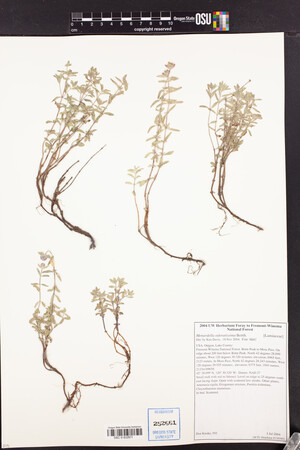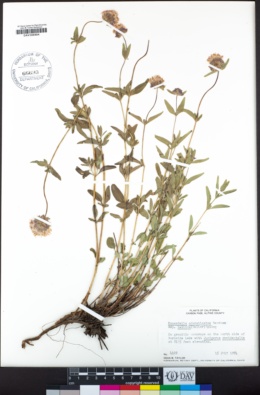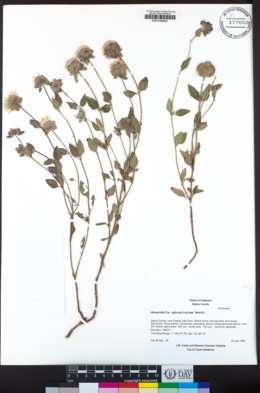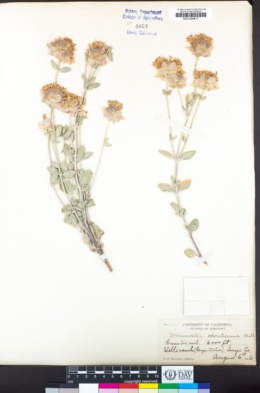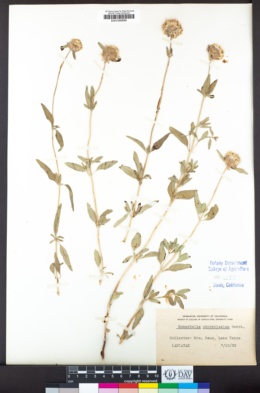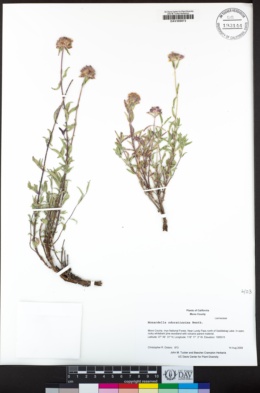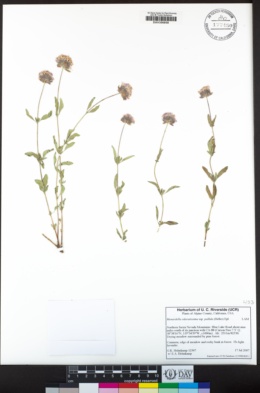Monardella odoratissima
|
|
|
|
Family: Lamiaceae
Alpine Mountainbalm, more...bee balm, mountain monardella, Pacific monardella
[Madronella odoratissima (Benth.) Greene, moreMadronella rubella (Greene) Greene] |
Plant: perennial herb; Stems several, (10-)25-35(-50) cm long, terete to 4-angled, sparsely to densely puberulent, tan, green, or gray, erect or decumbent, often with sterile lateral branches; rhizome stout, with peeling bark Leaves: petiole none, or up to 3 mm long; blades lanceolate to ovate, 0.7-3.5 cm long, 0.2-1.0 cm wide, sparsely puberulent, without stalked glands, the margin entire to serrulate, the apex acute or obtuse INFLORESCENCE: terminal, 1 per stem; all bracts sparsely pubescent to tomentose; bracts of outer whorl 2-5, spreading, leaf-like, lanceolate or elliptic, 5-25 mm long, 2-10 mm wide; bracts of inner whorl 5 or more, erect, forming an involucre, longer than calyces, ovate, 5- 12 mm long, 3-8 mm wide, with moderately to densely ciliate margins, often tinged purplish Flowers: calyx tubular, 5-9 mm long, at least half as long as corolla, moderately to densely villous, the lobes acute, linear to lanceolate; corolla tubular, 7-12 mm long, pink, or purple, rarely white, glabrous or minutely puberulent; stamens slightly unequal, the anthers divergent, often purple-colored; ovary 1-2 mm long; style to 1 cm long Fruit: NUTLETS oval to oblong, to 2 mm long, brown or tan, smooth Misc: Mostly in ponderosa pine and other coniferous forests; 1700-3350 m (5500-11000 ft); Mar-Oct REFERENCES: Trauth Nare, Amy E. 2003. Lamiaceae. J. Ariz. - Nev. Acad. Sci. Volume 35(2). Jepson 1993, Kearney and Peebles 1969, McDougall 1973, Christy et al. 2003 Duration: Perennial Nativity: Native Lifeform: Subshrub General: Low, bushy herbs with a woody base, stems several and ascending to decumbent, occasionally contorted, generally unbranched, to 30 cm tall, pubescent to canescent, pubescence curling downwards, without stipitate glands, plants aromatic. Leaves: Entire, lanceolate to ovate or oblong, glabrous to pubescent, 0.5-3.5 cm long, margin entire to serrulate, the apex acute to obtuse. Flowers: Lavender, red, or purple, borne in terminal, globose heads, subtended by ovate to rounded leafy bracts 5-25 mm long and 2-10 mm wide, sparsely puberulent, the bracts somewhat thinner than the leaves and in whorls, ciliate and tinged reddish-purple, cupping the inflorescences, the corolla tubes exserted from the tubular calyx which is 5-9 mm long, half as long as the corolla which is 7-12 mm long, bilabiate with wooly lobes, the upper lip 2-lobed, the lower lip 3-lobed, with 4 exserted stamens, the calyx 6-8 mm long with subequal, deltoid teeth. Fruits: Smooth, oblong nutlets approximately 2 mm long. Ecology: Found in coniferous forests, sagebrush scrub, and montane forests from 3,500-11,000 ft (1067-3353 m); flowering June-September. Notes: The keys to this species are the herbage without stipitate glands, the pubescence curling downward, and the ovate to orbicular bracts. The large purple flower heads are similar at first glance to those seen in the genus Monarda, but the smaller flowers with thin lobes and cupping bracts of Monardella are a good identifier for this species, (the other Monardella, Monardella arizonica, has spreading, narrowly ovate bracts and spreading pubescence. Christy et al. 2003 notes that there are 4 stamens in this genus, the generally single terminal verticil, and the unequal style branches are also keys. Ethnobotany: A decoction of the stems and flowers was taken for indigestion and flatulence, colds and fevers, used as a wash or inflamed eyes, and the plant was used as a sweat and love medicine, a blood and general tonic, and the leaves and flowers were used to make a non-medicinal tea. The plant was used during hunting to remove the human smell from lures, hooks, and traps by rubbing the plant on them. Etymology: Monardella is a diminutive of Monarda, having the general appearance of dwarfs of that genus , while odoratissima means fragrant, sweet-smelling. Synonyms: None Editor: LCrumbacher, 2011 |





